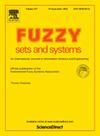容量不可加性指标的另一种观点:广义指标模型及其无监督容量辨识
IF 2.7
1区 数学
Q2 COMPUTER SCIENCE, THEORY & METHODS
引用次数: 0
摘要
非加性作为非加性测度的一个显著特征,是容量的重要性质。而非可加性指标是当前容量研究中提出的一个新概念,它对容量的非可加性进行了明确的处理,能够反映决策准则之间内部相互作用的类型和程度。然而,非可加性指标在容量识别中的影响和作用机制目前尚不清楚,特别是对于无监督学习识别方法。本文介绍了容量的广义非可加性指标及其有趣的无监督容量辨识,旨在提高非可加性指标的建模质量,揭示广义指标模型在高效容量辨识中的重要作用。首先给出了广义非可加性指标的定义,并详细探讨了相关的数学性质。在此基础上,提出了一种由广义非可加性指标引起的单调性约束的新形式,显示了在实际应用中提高容量识别效率的潜力。这直接导致我们提出了一种有趣的无监督容量识别方法,特别是在2加性情况下。通过我们的技术,通过将决策属性的约束数量从指数减少到线性,可以更有效地识别期望的单调2-加性容量,从而优于必须考虑二次单调约束的其他类型的方法。最后,提供了一个医疗保健供应商选择的实际案例来证明我们的建议的实用性。本文章由计算机程序翻译,如有差异,请以英文原文为准。
Another view on the non-additivity index of capacity: a generalized index model and the unsupervised capacity identification with it
Non-additivity as a remarkable feature of non-additive measures is an important property of capacity. And the non-additivity index is a new concept presented in the current study on capacity, which gives an explicit treatment of non-additivity of a capacity and can reflect the type and degree of internal interaction among decision criteria. However, the influence and mechanism of the non-additivity index in capacity identification are still unclear for now, especially for the unsupervised learning identification methods. This paper is dedicated to an introduction of the generalized non-additivity index of capacity and an interesting unsupervised capacity identification with it, aiming to improve the quality of the modeling for the non-additivity index and reveal significant roles of the generalized index model in capacity identification with high efficiency. To start with, the definition of the generalized non-additivity index is presented, with the associated mathematical properties explored in detail. On this basis, a novel form of monotonicity constraints induced by this generalized non-additivity index is created to show the potential of improving the efficiency of capacity identification for practical purposes. This directly leads to our proposal of an interesting unsupervised capacity identification method, especially in the 2-additive case. By our technique, a desired monotone 2-additive capacity can be identified more efficiently by reducing the number of constraints from exponential to linear in the number of decision attributes, thus outperforming other sorts of methods in which a quadratic number of monotonicity constraints have to be considered. Finally, a real-world case of healthcare supplier selection is provided to attest to the practicality of our proposal.
求助全文
通过发布文献求助,成功后即可免费获取论文全文。
去求助
来源期刊

Fuzzy Sets and Systems
数学-计算机:理论方法
CiteScore
6.50
自引率
17.90%
发文量
321
审稿时长
6.1 months
期刊介绍:
Since its launching in 1978, the journal Fuzzy Sets and Systems has been devoted to the international advancement of the theory and application of fuzzy sets and systems. The theory of fuzzy sets now encompasses a well organized corpus of basic notions including (and not restricted to) aggregation operations, a generalized theory of relations, specific measures of information content, a calculus of fuzzy numbers. Fuzzy sets are also the cornerstone of a non-additive uncertainty theory, namely possibility theory, and of a versatile tool for both linguistic and numerical modeling: fuzzy rule-based systems. Numerous works now combine fuzzy concepts with other scientific disciplines as well as modern technologies.
In mathematics fuzzy sets have triggered new research topics in connection with category theory, topology, algebra, analysis. Fuzzy sets are also part of a recent trend in the study of generalized measures and integrals, and are combined with statistical methods. Furthermore, fuzzy sets have strong logical underpinnings in the tradition of many-valued logics.
 求助内容:
求助内容: 应助结果提醒方式:
应助结果提醒方式:


